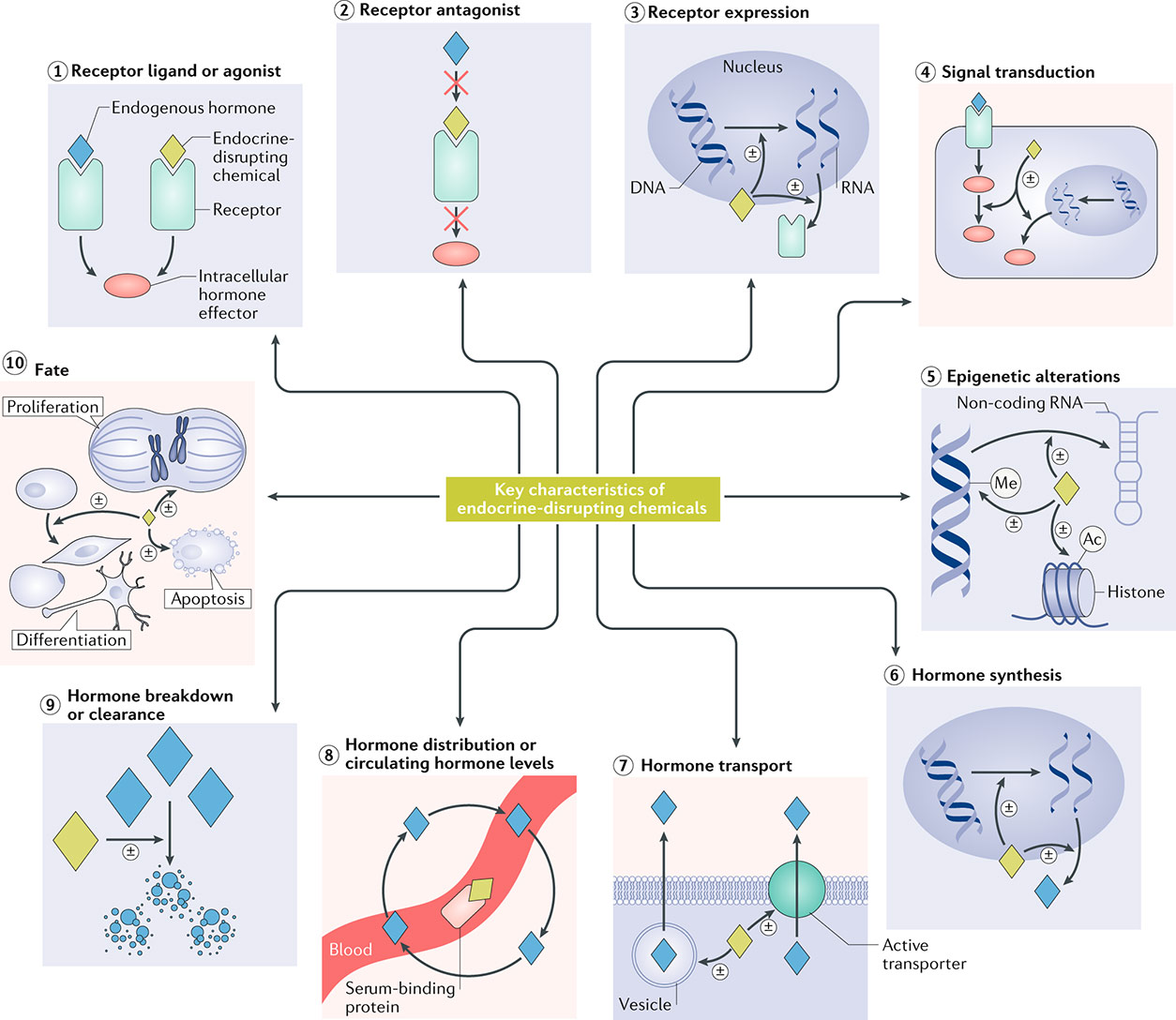A consensus statement that lays out 10 key characteristics of endocrine-disrupting chemicals (EDCs) could provide a universal framework for assessing risks these chemicals present. The statement, published Nov. 12 in Nature Reviews Endocrinology, was co-written by NIEHS-funded scientists and funded in part by the Research Translation Core of the NIEHS Superfund Research Center at the University of California at Berkeley.
 Zoeller’s research interests include thyroid hormone action on brain development and environmental disruption of thyroid hormone action. (Photo courtesy of R. Thomas Zoeller)
Zoeller’s research interests include thyroid hormone action on brain development and environmental disruption of thyroid hormone action. (Photo courtesy of R. Thomas Zoeller)“The general public is increasingly becoming aware that industrial chemicals used in food processing, food packaging, personal care, and other consumer products have the potential of causing harm,” said consensus statement co-author and former NIEHS grantee R. Thomas Zoeller, Ph.D., from the University of Massachusetts. “The key characteristic approach to identifying endocrine-disrupting chemicals is a first step in developing a rational risk-assessment strategy to protect public health.”
“The key characteristics of endocrine-disrupting chemicals are the functional properties of agents that alter the action of hormones,” explained consensus statement first author Michele La Merrill, Ph.D., from the University of California Davis. “These key characteristics involve the major mechanisms by which hormone systems can be disrupted, including by interfering with what they do, how they do it, and how they are controlled.” LaMerrill is a member of the NIEHS-funded UCD Environmental Health Sciences Center.
Endocrine biology
Studies have provided evidence of hazards to the body from exposure to EDCs (see sidebar). But there has been no widely accepted, systematic method of integrating all these data in a way that helps identify a specific substance as an EDC.
Even the definition of an endocrine disruptor has been debated for years, according to co-author and NIEHS grantee Heather Patisaul, Ph.D., associate dean for research at North Carolina State University.
 Patisaul spoke at NIEHS at a meeting of North Carolina scientists who study endocrine disruptors, at which she chaired a panel on emerging contaminants. (Photo courtesy of Steve McCaw)
Patisaul spoke at NIEHS at a meeting of North Carolina scientists who study endocrine disruptors, at which she chaired a panel on emerging contaminants. (Photo courtesy of Steve McCaw)“Here we took a step back and asked, what do endocrine-disrupting chemicals actually do in the body? What does the endocrine system look like when it's perturbed? Can we define what endocrine disruption means in terms of how biology is influenced?” Patisaul said.
“This was an ideal opportunity to take stock of the science and identify what would constitute hallmarks of endocrine disruption on molecular and cellular levels,” she added.
Holistic approach
The statement’s authors were inspired by International Agency for Research on Cancer efforts to use key characteristics as a way to identify carcinogens. Instead of a narrow focus on specific pathways and hypotheses, it favors a broad, holistic consideration of mechanistic evidence.
“A clear outcome of this exercise was the realization that our present toxicity testing scheme for endocrine-disrupting chemicals is woefully insufficient and does not account for all the ways in which the endocrine system can be harmed,” Patisaul said. “This document could be used to help shore up those testing gaps and prioritize future research needs.”
According to Patisaul, hormone receptor binding has historically been the primary experimental and regulatory testing focus. By contrast, other mechanisms of the endocrine system have gotten less attention.
“We found that only three of the 10 ways in which endocrine-disrupting chemicals can act on the body are robustly considered in chemical testing programs,” Patisaul said. “We badly need assays for the other seven to fully account for all the ways in which endocrine-disrupting chemicals can alter our physiology.”
“By defining what constitutes endocrine-disrupting activity, we allow for the identification of these chemicals much more readily and, hopefully, before they can cause widespread human disease,” she explained.
 Korach’s group studies processes involved in the activation of the estrogen receptor and its role in mediating biological responses. (Photo courtesy of Steve McCaw)
Korach’s group studies processes involved in the activation of the estrogen receptor and its role in mediating biological responses. (Photo courtesy of Steve McCaw)Powerful framework, but not a checklist
The consensus statement authors caution that the key characteristics should not be used as a checklist. Strong evidence for one key characteristic could be enough. For example, perchlorate has only one key characteristic, but its endocrine-disrupting activity is strongly supported by human and experimental evidence.
“It is critical in all circumstances to recognize that identifying an endocrine-disrupting chemical is not merely counting the sum of key characteristics [that have] supporting evidence,” said consensus statement co-author Kenneth Korach, Ph.D., NIEHS emeritus scientist. “Hormones generally act through entire systems, and one key characteristic might be sufficient to disrupt an entire system.”
Citation: La Merrill MA, Vandenberg LN, Smith MT, Goodson W, Browne P, Patisaul HB, Guyton KZ, Kortenkamp A, Cogliano VJ, Woodruff TJ, Rieswijk L, Sone H, Korach KS, Gore AC, Zeise L, Zoeller RT. 2019. Consensus on the key characteristics of endocrine-disrupting chemicals as a basis for hazard identification. Nat Rev Endocrinol. doi: 10.1038/s41574-019-0273-8.
(Janelle Weaver, Ph.D., is a contract writer for the NIEHS Office of Communications and Public Liaison.)
Creative Commons Attribution 4.0 International License.) (Photo courtesy of )'>
Illustrated actions of the key characteristics of endocrine-disrupting chemicals (see sidebar). Ac, acetyl group; Me, methyl group. (Photo courtesy of the authors and Nature Reviews Endocrinology under a Creative Commons Attribution 4.0 International License.)









